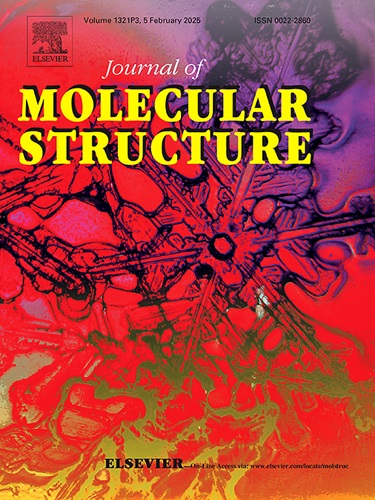Silver oxide embedded alkali zinc boro tellurite glasses: Physical, structural and optical properties for possible optical switching applications
IF 4
2区 化学
Q2 CHEMISTRY, PHYSICAL
引用次数: 0
Abstract
A new set of alkali zinc boro tellurite glasses activated with silver oxide was prepared by the melt quenching method to investigate their suitability for significant applications in optical switching and optical device applications. The XRD is carried out to check the non-crystalline nature of the BTZNA glasses. The impact of the addition of Ag2O to the ZnO-B2O3-TeO2![]() Na2O glasses causes structural changes due to the interconversion of BO4 and BO3 units, which was noticed by FTIR and deconvoluted FTIR spectra, and FTIR is also evidence of the presence of TeO3+1 (polyhedral) and TeO3 (trigonal pyramid) units, Zn-O vibrations of ZnO4 units. Physical properties such as density, molar volume, polaron radius, and oxygen packing density were determined by using a suitable mathematical approach. The optical absorption of BTZNA glasses was performed by using UV–visible spectroscopy, and hence, important optical properties of the glasses like direct and indirect energy band gaps, Urbach energy, refractive index, metallization criterion, and optical basicity are calculated. The highest RI is observed as 2.222 for BTNAZ2 glasses. The indirect energy band gap of prepared glasses ranges from 3.22 eV to 3.26 eV. The observed physical, structural, and optical properties of the glasses show these glasses are potentially good materials for optical material and optical switching applications.
Na2O glasses causes structural changes due to the interconversion of BO4 and BO3 units, which was noticed by FTIR and deconvoluted FTIR spectra, and FTIR is also evidence of the presence of TeO3+1 (polyhedral) and TeO3 (trigonal pyramid) units, Zn-O vibrations of ZnO4 units. Physical properties such as density, molar volume, polaron radius, and oxygen packing density were determined by using a suitable mathematical approach. The optical absorption of BTZNA glasses was performed by using UV–visible spectroscopy, and hence, important optical properties of the glasses like direct and indirect energy band gaps, Urbach energy, refractive index, metallization criterion, and optical basicity are calculated. The highest RI is observed as 2.222 for BTNAZ2 glasses. The indirect energy band gap of prepared glasses ranges from 3.22 eV to 3.26 eV. The observed physical, structural, and optical properties of the glasses show these glasses are potentially good materials for optical material and optical switching applications.
氧化银嵌套碱锌波罗碲酸盐玻璃:用于可能的光开关应用的物理、结构和光学特性
采用熔体猝灭法制备了一套氧化银活化的碱锌波罗碲酸盐玻璃,考察了其在光开关和光器件应用中的适用性。采用XRD对BTZNA玻璃的非晶性进行了表征。Ag2O的加入对ZnO-B2O3-TeO2Na2O玻璃的影响是由于BO4和BO3单元的相互转化引起的结构变化,FTIR和反卷积FTIR光谱都注意到了这一点,FTIR也证明了TeO3+1(多面体)和TeO3(三角金字塔)单元的存在,ZnO4单元的Zn-O振动。物理性质如密度、摩尔体积、极化子半径和氧堆积密度是用合适的数学方法确定的。利用紫外可见光谱法对BTZNA玻璃的光学吸收进行了分析,计算出了BTZNA玻璃的直接能带隙、间接能带隙、乌尔巴赫能、折射率、金属化判据、光学碱度等重要光学性质。BTNAZ2玻璃的最高RI为2.222。所得玻璃的间接能带隙在3.22 ~ 3.26 eV之间。观察到的玻璃的物理、结构和光学性质表明,这些玻璃是光学材料和光开关应用的潜在良好材料。
本文章由计算机程序翻译,如有差异,请以英文原文为准。
求助全文
约1分钟内获得全文
求助全文
来源期刊

Journal of Molecular Structure
化学-物理化学
CiteScore
7.10
自引率
15.80%
发文量
2384
审稿时长
45 days
期刊介绍:
The Journal of Molecular Structure is dedicated to the publication of full-length articles and review papers, providing important new structural information on all types of chemical species including:
• Stable and unstable molecules in all types of environments (vapour, molecular beam, liquid, solution, liquid crystal, solid state, matrix-isolated, surface-absorbed etc.)
• Chemical intermediates
• Molecules in excited states
• Biological molecules
• Polymers.
The methods used may include any combination of spectroscopic and non-spectroscopic techniques, for example:
• Infrared spectroscopy (mid, far, near)
• Raman spectroscopy and non-linear Raman methods (CARS, etc.)
• Electronic absorption spectroscopy
• Optical rotatory dispersion and circular dichroism
• Fluorescence and phosphorescence techniques
• Electron spectroscopies (PES, XPS), EXAFS, etc.
• Microwave spectroscopy
• Electron diffraction
• NMR and ESR spectroscopies
• Mössbauer spectroscopy
• X-ray crystallography
• Charge Density Analyses
• Computational Studies (supplementing experimental methods)
We encourage publications combining theoretical and experimental approaches. The structural insights gained by the studies should be correlated with the properties, activity and/ or reactivity of the molecule under investigation and the relevance of this molecule and its implications should be discussed.
 求助内容:
求助内容: 应助结果提醒方式:
应助结果提醒方式:


